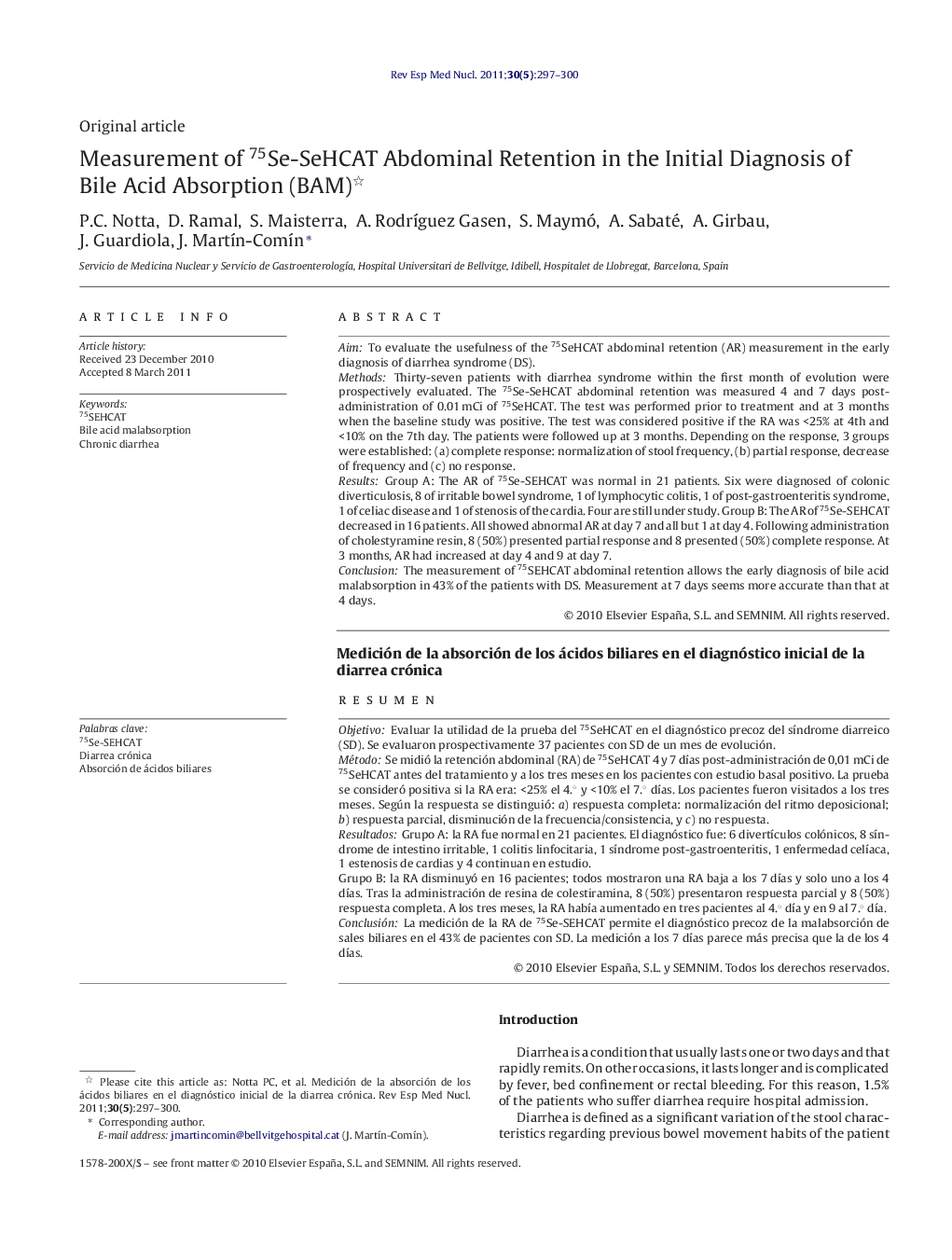| Article ID | Journal | Published Year | Pages | File Type |
|---|---|---|---|---|
| 4249427 | Revista Española de Medicina Nuclear (English Edition) | 2011 | 4 Pages |
AimTo evaluate the usefulness of the 75SeHCAT abdominal retention (AR) measurement in the early diagnosis of diarrhea syndrome (DS).MethodsThirty-seven patients with diarrhea syndrome within the first month of evolution were prospectively evaluated. The 75Se-SeHCAT abdominal retention was measured 4 and 7 days post-administration of 0.01 mCi of 75SeHCAT. The test was performed prior to treatment and at 3 months when the baseline study was positive. The test was considered positive if the RA was <25% at 4th and <10% on the 7th day. The patients were followed up at 3 months. Depending on the response, 3 groups were established: (a) complete response: normalization of stool frequency, (b) partial response, decrease of frequency and (c) no response.ResultsGroup A: The AR of 75Se-SEHCAT was normal in 21 patients. Six were diagnosed of colonic diverticulosis, 8 of irritable bowel syndrome, 1 of lymphocytic colitis, 1 of post-gastroenteritis syndrome, 1 of celiac disease and 1 of stenosis of the cardia. Four are still under study. Group B: The AR of 75Se-SEHCAT decreased in 16 patients. All showed abnormal AR at day 7 and all but 1 at day 4. Following administration of cholestyramine resin, 8 (50%) presented partial response and 8 presented (50%) complete response. At 3 months, AR had increased at day 4 and 9 at day 7.ConclusionThe measurement of 75SEHCAT abdominal retention allows the early diagnosis of bile acid malabsorption in 43% of the patients with DS. Measurement at 7 days seems more accurate than that at 4 days.
ResumenObjetivoEvaluar la utilidad de la prueba del 75SeHCAT en el diagnóstico precoz del síndrome diarreico (SD). Se evaluaron prospectivamente 37 pacientes con SD de un mes de evolución.MétodoSe midió la retención abdominal (RA) de 75SeHCAT 4 y 7 días post-administración de 0,01 mCi de 75SeHCAT antes del tratamiento y a los tres meses en los pacientes con estudio basal positivo. La prueba se consideró positiva si la RA era: <25% el 4.° y <10% el 7.° días. Los pacientes fueron visitados a los tres meses. Según la respuesta se distinguió: a) respuesta completa: normalización del ritmo deposicional; b) respuesta parcial, disminución de la frecuencia/consistencia, y c) no respuesta.ResultadosGrupo A: la RA fue normal en 21 pacientes. El diagnóstico fue: 6 divertículos colónicos, 8 síndrome de intestino irritable, 1 colitis linfocitaria, 1 síndrome post-gastroenteritis, 1 enfermedad celíaca, 1 estenosis de cardias y 4 continuan en estudio.Grupo B: la RA disminuyó en 16 pacientes; todos mostraron una RA baja a los 7 días y solo uno a los 4 días. Tras la administración de resina de colestiramina, 8 (50%) presentaron respuesta parcial y 8 (50%) respuesta completa. A los tres meses, la RA había aumentado en tres pacientes al 4.° día y en 9 al 7.° día.ConclusiónLa medición de la RA de 75Se-SEHCAT permite el diagnóstico precoz de la malabsorción de sales biliares en el 43% de pacientes con SD. La medición a los 7 días parece más precisa que la de los 4 días.
